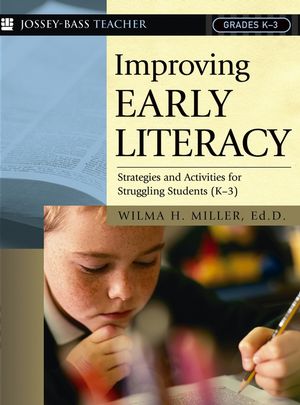Improving Early Literacy: Strategies and Activities for Struggling Students (K-3)ISBN: 978-0-7879-7289-9
Paperback
352 pages
November 2004, Jossey-Bass
 This is a Print-on-Demand title. It will be printed specifically to fill your order. Please allow an additional 10-15 days delivery time. The book is not returnable.
|
||||||
Acknowledgments.
About the Author.
Chapter 1: A Practical Introduction to Early Literacy.
A Brief Description of Early Literacy.
The Rationale for Developing Early Literacy Skills in Early Childhood Programs.
Whole Language and Its Place in Early Literacy Instruction.
Whole Language and Children Who Have Special Needs.
Whole Language and Children Who Have Average Linguistic Skills.
Whole Language and Children Who Have Above Average Linguistic Skills.
The Language-Experience Approach (LEA) in Early Literacy Programs.
The Language-Experience Approach for Children Who Have Special Needs.
The Language-Experience Approach for Children with Average Linguistic Skills.
The Language-Experience Approach for Children with Above Average Linguistic Skills.
Chapter 2: Assessment Devices in Early Literacy Programs.
Standardized Tests and Their Major Advantages and Limitations.
Informal Assessment in Early Literacy Programs.
Checklist of Primary-Grade Writing Behaviors.
Chapter 3: Listening and Oral Language Skills.
Listening.
Oral Language.
Theories of Oral Language Development.
Stages of Oral Language Development.
Chapter 4: Letter-Name and Sight-Word Knowledge.
Letter-Name Recognition and Identification.
Sight-Word Recognition and Identification.
Chapter 5: Improving Competency in Phonics.
Phonemic Awareness.
Phonics.
The Most Common Phonic Elements.
Chapter 6: Improving Ability in Word Structure and Context.
Word Structure.
Context Clues.
Chapter 7: Improving Ability in Vocabulary and Comprehension.
Types of Meaning Vocabularies and Their Relation to Reading Achievement.
Reading Comprehension.
Appendix I: Big Book Resources.
Appendix II: Predictable Books.
Appendix III: Recommended LEA Resources.
Appendix IV: For Additional Reading.
Appendix V: Chants, Finger Plays, Action Verses, and Recommended Books.
Appendix VI: Wordless Books.
Appendix VII: The Dolch Basic Sight Words.
Appendix VIII: Books for Reviewing Individual Letter Names.
Appendix IX: Cooking and Baking Activities to Review Letter Names.
Appendix X: Contemporary Easy-to-Read Trade Books.
Appendix XI: Further Reading on Phonics.
Appendix XII: Trade Books for Improving Phonic Skills in Context.
Appendix XIII: Books to Promote Enjoyment of Words.
Appendix XIV: Poetry Books for Young Children.
Appendix XV: Books for Visual Imagery.
Bibliography.
Answer Key.



